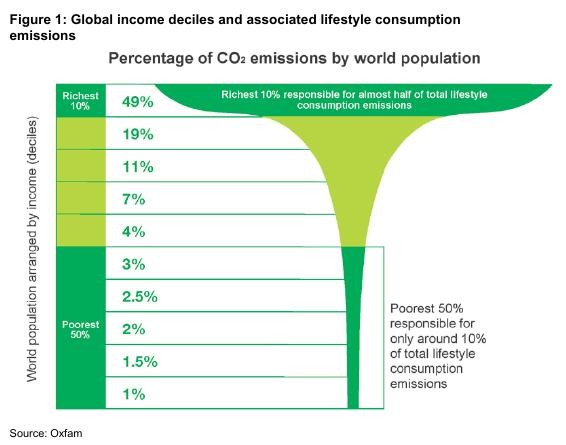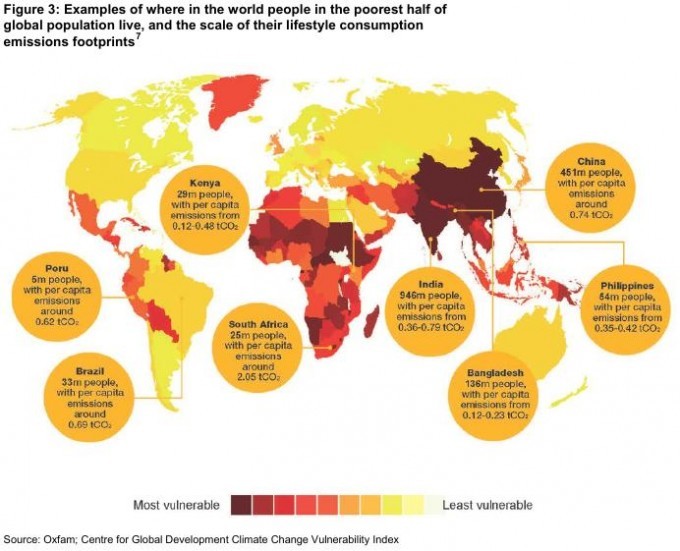Richest 10% Responsible for 50% of Consumption-Related Emissions
December 02, 2015
on
on

The poorest 50% of the global population produce only 10% of lifestyle-related emissions worldwide. At the same time the poorest will be hit hardest by the effects of climate change. On the other end of the spectrum the richest 10% is responsible for half the global lifestyle-related emissions.
In a report released on Wednesday Oxfam International compares the lifestyle consumption emissions of rich and poor people around the world. Lifestyle consumption emissions are an estimated 64% of all global emissions. The remaining 36% is attributed to consumption by governments, investments (e.g. infrastructure) and international transport.
The average carbon footprint of the rich is 11 times as high as those of the poorest 3.5 billion people in the world and even 60 times when compared to the poorest 10%. “Climate change is inextricably linked to economic inequality: it is a crisis that is driven by the greenhouse gas emissions of the ‘haves’ that hits the ‘have-nots’ the hardest”, the report states.

At COP21 in Paris much of the focus is on emerging countries with high emission levels such as China and India, says the international aid organization, but the lifestyle consumption emissions per capita are much higher in developed countries than in developing countries. Highlighting both carbon inequality and economic inequality Oxfam International urges the Paris negotiators toward a fair global climate agreement: “The litmus test of the deal will be whether it delivers something for the poorest people who are both the least responsible for and the most vulnerable to climate change, wherever they live”
But even though the poor are worst off, ordinary citizens in rich countries will benefit from a strong deal as well. An increasing number of people are demanding climate action as they are beginning to experience the impact of climate change.
“The only beneficiaries of inadequate climate action in Paris and beyond are a much smaller elite with vested interests in the continuation of a high carbon and deeply unequal global economy. Between the Copenhagen and Paris climate conferences, the number of billionaires on the Forbes list with interests in fossil fuel activities has risen from 54 in 2010 to 88 in 2015, while the size of their combined personal fortunes has expanded by around 50% from over $200bn to more than $300bn . Governments in Paris need to stand up to their influence, and stand up for their citizens – the poorest, lowest emitting and most vulnerable among them first and foremost – if Paris is to deliver an agreement for those who need it most.”

Image: Oxfam distributing clean water to a drought-stricken area in southern Ethiopia. Courtesy: Oxfam. CC-BY licence.
In a report released on Wednesday Oxfam International compares the lifestyle consumption emissions of rich and poor people around the world. Lifestyle consumption emissions are an estimated 64% of all global emissions. The remaining 36% is attributed to consumption by governments, investments (e.g. infrastructure) and international transport.
The average carbon footprint of the rich is 11 times as high as those of the poorest 3.5 billion people in the world and even 60 times when compared to the poorest 10%. “Climate change is inextricably linked to economic inequality: it is a crisis that is driven by the greenhouse gas emissions of the ‘haves’ that hits the ‘have-nots’ the hardest”, the report states.

At COP21 in Paris much of the focus is on emerging countries with high emission levels such as China and India, says the international aid organization, but the lifestyle consumption emissions per capita are much higher in developed countries than in developing countries. Highlighting both carbon inequality and economic inequality Oxfam International urges the Paris negotiators toward a fair global climate agreement: “The litmus test of the deal will be whether it delivers something for the poorest people who are both the least responsible for and the most vulnerable to climate change, wherever they live”
But even though the poor are worst off, ordinary citizens in rich countries will benefit from a strong deal as well. An increasing number of people are demanding climate action as they are beginning to experience the impact of climate change.
“The only beneficiaries of inadequate climate action in Paris and beyond are a much smaller elite with vested interests in the continuation of a high carbon and deeply unequal global economy. Between the Copenhagen and Paris climate conferences, the number of billionaires on the Forbes list with interests in fossil fuel activities has risen from 54 in 2010 to 88 in 2015, while the size of their combined personal fortunes has expanded by around 50% from over $200bn to more than $300bn . Governments in Paris need to stand up to their influence, and stand up for their citizens – the poorest, lowest emitting and most vulnerable among them first and foremost – if Paris is to deliver an agreement for those who need it most.”

Image: Oxfam distributing clean water to a drought-stricken area in southern Ethiopia. Courtesy: Oxfam. CC-BY licence.
Read full article
Hide full article


Discussion (0 comments)